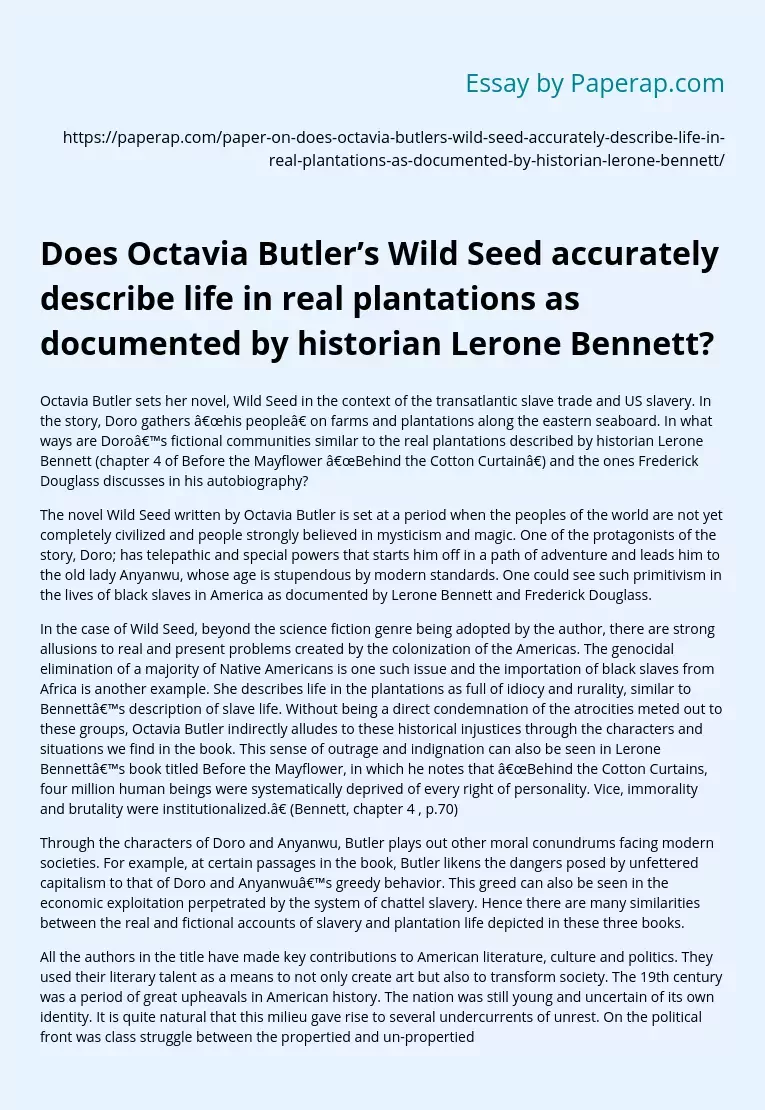Octavia Butler's Wild Seed vs Real Plantations
Octavia Butler sets her novel, Wild Seed in the context of the transatlantic slave trade and US slavery. In the story, Doro gathers “his people” on farms and plantations along the eastern seaboard. In what ways are Doro’s fictional communities similar to the real plantations described by historian Lerone Bennett (chapter 4 of Before the Mayflower “Behind the Cotton Curtain”) and the ones Frederick Douglass discusses in his autobiography?
The novel Wild Seed written by Octavia Butler is set at a period when the peoples of the world are not yet completely civilized and people strongly believed in mysticism and magic.
One of the protagonists of the story, Doro; has telepathic and special powers that starts him off in a path of adventure and leads him to the old lady Anyanwu, whose age is stupendous by modern standards. One could see such primitivism in the lives of black slaves in America as documented by Lerone Bennett and Frederick Douglass.
In the case of Wild Seed, beyond the science fiction genre being adopted by the author, there are strong allusions to real and present problems created by the colonization of the Americas.
The genocidal elimination of a majority of Native Americans is one such issue and the importation of black slaves from Africa is another example. She describes life in the plantations as full of idiocy and rurality, similar to Bennett’s description of slave life. Without being a direct condemnation of the atrocities meted out to these groups, Octavia Butler indirectly alludes to these historical injustices through the characters and situations we find in the book.
This sense of outrage and indignation can also be seen in Lerone Bennett’s book titled Before the Mayflower, in which he notes that “Behind the Cotton Curtains, four million human beings were systematically deprived of every right of personality. Vice, immorality and brutality were institutionalized.” (Bennett, chapter 4 , p.70)
Through the characters of Doro and Anyanwu, Butler plays out other moral conundrums facing modern societies. For example, at certain passages in the book, Butler likens the dangers posed by unfettered capitalism to that of Doro and Anyanwu’s greedy behavior. This greed can also be seen in the economic exploitation perpetrated by the system of chattel slavery. Hence there are many similarities between the real and fictional accounts of slavery and plantation life depicted in these three books.
All the authors in the title have made key contributions to American literature, culture and politics. They used their literary talent as a means to not only create art but also to transform society. The 19th century was a period of great upheavals in American history. The nation was still young and uncertain of its own identity. It is quite natural that this milieu gave rise to several undercurrents of unrest. On the political front was class struggle between the propertied and un-propertied whites. In terms of social equations, the blacks were hoping for the abolishment of slavery. Women were still thought of as ‘property’ of their fathers or husbands or sons, let alone having the right to vote. In terms of general culture, the population was highly illiterate. It is these pressing issues that writers such as Melville, Douglass and Fuller sought to address through their work. It can be claimed that their efforts were not in vain, given how much the country has progressed in .
Octavia Butler's Wild Seed vs Real Plantations. (2019, Feb 19). Retrieved from https://paperap.com/paper-on-does-octavia-butlers-wild-seed-accurately-describe-life-in-real-plantations-as-documented-by-historian-lerone-bennett/

